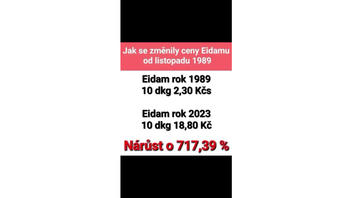
Does comparing the price of cheese before communism and now prove that the standard of living in the Czech Republic before the Velvet Revolution in 1989 was higher than it is now? No, that's not true: Such a comparison is a complex issue that includes many other factors, such as wage growth. Besides, in the case of cheese and most other items, people's incomes grew faster than the cost of goods.
The claim appeared in a video (archived here) published on TikTok on September 11, 2024. The picture in the video says that the price for 100 grams of Eidam cheese was 2.3 Czechoslovak korunas in 1989, compared to 18.8 Czech korunas in 2023, which means the price increased by 717.39 percent. The voice over the video says in Czech, translated by Lead Stories as:
This is mostly for the young people who applaud what's happening right now in the world in general, that's how we used to live folks.
This is what the post looked like on TikTok at the time of writing:
(Source: TikTok screenshot taken on Thu Sep 26 08:09:39 2024 UTC)
The data cited in the picture used in the TikTok video above about cheese prices is correct. It matches the data provided by the Czech Statistical Office (CSU) (archived here) on its website, which lists prices of goods before and after the Velvet Revolution that overthrew communism in 1989. According to the CSU, the table shows the inflation rate and the development of some goods prices, including the data for 1 kilogram of Eidam cheese, which was 23 crowns in 1989 and 187.99 crowns in 2023.
Meanwhile, the monthly gross wage rose to 3,170 korunas in 1989, CSU said in an e-mail to Lead Stories on Oct. 1, 2024, as the data are unavailable online (TK). In the fourth quarter of 2023, the average gross wage amounted to 46,013 Czech korunas, according to CSU data found here (archived here).
According to Lead Story's calculations using CSU data, the price of Eidam cheese increased 717.4 percent from 1989 to 2023, while the average gross wage increased by 1,351.5 percent in the same period, so the numbers do not prove that people were better off during communism.
Other economic parameters can indicate greater prosperity, such as GDP growth or GDP per capita, which measure a country's economic development. According to CSU data (archived here), GDP per capita grew tenfold from $3,077 in 1990 to $30,890 in 2023. GDP per capita (archived here) indicates economic growth, and a rising measure indicates greater prosperity. According to the CSU, there is no comparable data from communism before 1990.
However, as pointed out in the article (archived here) published on the website of Masaryk University in November 2018, the economic activity under communism was centrally planned, and companies were primarily concerned with meeting the set plan, while efficiency was not a concern. As a result, the Czechoslovak economy always lagged. GDP per capita in 1948 was comparable to that of Austria. In 1989, it was only half or a third, and Czechoslovak production was, for the most part, completely uncompetitive internationally, the article says.
Another measure that can be considered is the Gini index (archived here), which measures the inequality of disposable income across the population. According to World Bank data (archived here), the Czech Republic is among the 10 countries with the lowest Gini index in the world. The measure also changed "very little" between 1989 and 1993, during the transition from communism, according to an analysis published in 1998 (archived here).
The Czech Chamber of Commerce also published a press release (archived here) in 2023 about the transformation of the economy and changes in the cost of living after 1989, noting that the "key change" was the liberalization of prices after 1989. Before 1989, prices were regulated and kept artificially low, resulting in shortages of certain goods, the release said. The analysis concluded that after 34 years, wages are 14 times higher, while prices are seven times higher than in 1989.
The website zakomunismu.cz (archived here) compares incomes and prices in 2022 with similar items under socialism in 1989. According to the website's calculator, while most items were cheaper in 2022, a few, such as movie tickets, postal fees, garbage collection, or bread, are more expensive now than in 1989.
Czech media have published several articles about the topic, concluding that people were not better off during communism as prices grew less than wages. Aktualne.cz, a Czech news website, also published an article challenging a notion (archived here) that people did better under communism by calculating the cost of daily grocery shopping in relation to the average income in 1989 and 2021.
In 2014, Lidovky.cz, a website of the Czech daily Lidove Noviny, published an article (archived here) stating that people had to save 34 monthly wages to buy a car, while in 2014, only 12 salaries were needed.
The idea the Czechs were better off during communism remains quite widespread: according to a 2019 study carried out for a Czech NGO, Pamet Naroda, about a third of the population has this conviction. The study is no longer available online, the NGO´s spokeswoman told Lead Stories over the phone on September 30, 2024. Newspaper articles referencing the poll in 2019 can be found here (archived here) or here (archived here).








